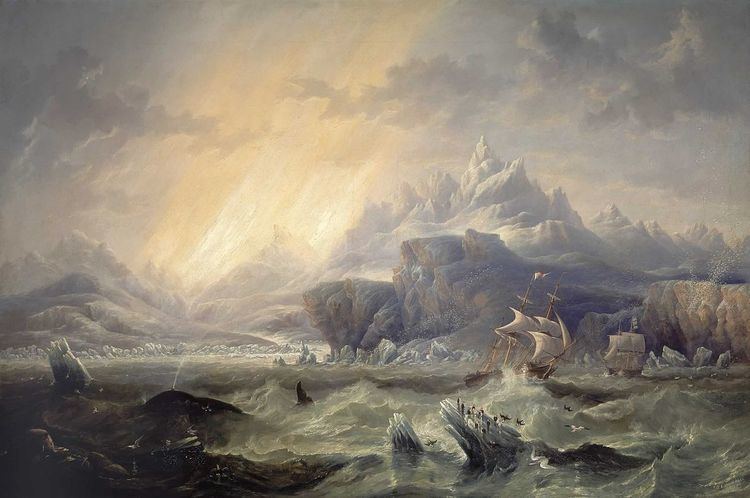Dates 30 Sep 1839 – 4 Sep 1843 | ||
 | ||
The Ross expedition was a voyage of scientific exploration of the Antarctic in 1839 to 1843, led by James Clark Ross, with two unusually strong warships, HMS Erebus and HMS Terror. It explored what is now called the Ross Sea and discovered the Ross Ice Shelf. On the expedition, Ross discovered the Transantarctic Mountains and the volcanoes Erebus and Terror, named after his ships. The young botanist Joseph Dalton Hooker made his name on the expedition.
Contents
The expedition inferred the position of the South Magnetic Pole, and made substantial observations of the zoology and botany of the region, resulting in a monograph on the zoology, and a series of four detailed monographs by Hooker on the botany, collectively called Flora Antarctica and published in parts between 1843 and 1859. The expedition was the last major voyage of exploration made wholly under sail.
Among the expedition's biological discoveries was the Ross seal, a species confined to the pack ice of Antarctica.
People
The expedition was led by a Captain of the Royal Navy, James Clark Ross, who commanded Erebus. Terror was commanded by Francis Crozier.
The botanist Joseph Dalton Hooker, then aged 23 and the youngest person on the expedition, was assistant-surgeon to Robert McCormick. and was responsible for collecting zoological and geological specimens. Hooker later became one of England's greatest botanists; he was a close friend of Charles Darwin, and became director of the Royal Botanical Gardens, Kew for twenty years. McCormick had been ship's surgeon for the second voyage of HMS Beagle under Captain Robert FitzRoy, along with Darwin as gentleman naturalist.
Ships
The expedition was made in two unusually strong warships, HMS Erebus and HMS Terror. Both were bomb ships, named and equipped to fire heavy mortar bombs at a high angle over defences, and were accordingly heavily built to withstand the substantial recoil of these three-ton weapons. Their solid construction ideally suited them for use in dangerous sea ice, which might crush other ships. The 372-ton Erebus had been armed with two mortars – one 13 in (330 mm) and one 10 in (250 mm) – and 10 guns.
Voyage
On 21 November 1840 – captained by James Clark Ross – the Erebus and the Terror departed from Tasmania for Antarctica. In January 1841, the crew of both ships landed on Victoria Land, and proceeded to name areas of the landscape after British politicians, scientists, and acquaintances. Mount Erebus, on Ross Island, was named after one ship and Mount Terror after the other.
They then discovered the Ross Ice Shelf, which they were unable to penetrate, and followed it eastward until the lateness of the season compelled them to return to Tasmania. The following season, 1842, Ross continued to survey the "Great Ice Barrier", as it was called, continuing to follow it eastward. Both ships returned to the Falkland Islands before returning to the Antarctic in the 1842–1843 season. They conducted studies in magnetism, and returned with oceanographic data and collections of botanical and ornithological specimens.
The ships arrived back in England on 4 September 1843, having confirmed the existence of the southern continent and charted a large part of its coastline.
Geography
Ross discovered the "enormous" Ross Ice Shelf, correctly observing that it was the source of the tabular icebergs seen in the Southern Ocean, and helping to found the science of glaciology.
Magnetism
The main purpose of the Ross expedition was to find the position of the South Magnetic Pole, by making observations of the Earth's magnetism in the Southern hemisphere. Ross did not reach the Pole, but did infer its position. The expedition made the first "definitive" charts of magnetic declination, magnetic dip and magnetic intensity, in place of the less good charts made by the earlier expeditions of Charles Wilkes and Dumont d'Urville.
Zoology
The expedition's zoological discoveries included a collection of birds. They were described and illustrated by George Robert Gray and Richard Bowdler Sharpe in The Zoology of the Voyage of HMS Erebus & HMS Terror.
The expedition was the first to describe the Ross seal, which it found in the pack ice, to which the species is confined.
Botany
The expedition's botanical discoveries were documented in J. D. Hooker's four-part Flora Antarctica (1843-1859). It totalled six volumes (parts III and IV each being in two volumes), covered about 3000 species, and contained 530 plates figuring in all 1095 of the species described. It was throughout "splendidly" illustrated by Walter Hood Fitch. The parts were:
Hooker gave Charles Darwin a copy of the first part of the Flora; Darwin thanked him, and agreed in November 1845 that the geographical distribution of organisms would be "the key which will unlock the mystery of species".
Influence
In 1912, the Norwegian explorer Roald Amundsen wrote of the Ross expedition that "Few people of the present day are capable of rightly appreciating this heroic deed, this brilliant proof of human courage and energy. With two ponderous craft - regular "tubs" according to our ideas - these men sailed right into the heart of the pack [ice], which all previous explorers had regarded as certain death ... These men were heroes - heroes in the highest sense of the word."
Hooker's Flora Antarctica remains important; in 2013 W. H. Walton in his Antarctica: Global Science from a Frozen Continent describes it as "a major reference to this day", encompassing as it does "all the plants he found both in the Antarctic and on the sub-Antarctic islands", surviving better than Ross's deep-sea soundings which were made with "inadequate equipment".
